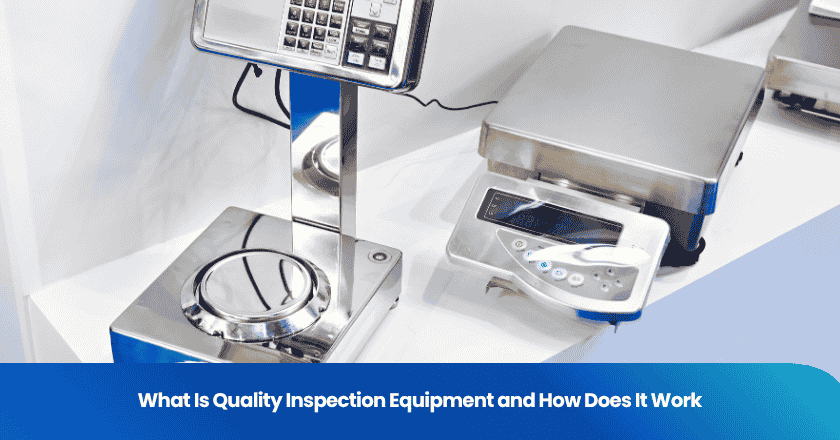
You rely on quality inspection equipment to ensure every product meets strict standards before it reaches your customers. This technology allows you to detect defects, maintain consistency, and improve overall quality in your operations. You may choose manual tools for hands-on checks or automated systems for faster, more precise inspections. Both approaches help you prevent costly errors and protect your reputation.
What is Quality Inspection Equipment
Definition and Purpose
You use quality inspection equipment to verify that products meet specific standards before they leave the production line. This equipment helps you identify defects, measure product characteristics, and ensure consistency in manufacturing. According to ISO 2859, quality inspection involves activities such as testing, gauging, examining, or measuring. You compare the results against requirements to determine if products conform to expectations.
You aim to catch errors early in the process. The sooner you detect a problem, the easier and less expensive it is to fix. Early identification of defects saves you time and reduces costs. You also fulfill customer expectations by preventing defective products from reaching the market. Inspections at different stages of production help you avoid failures that may not be visible or fixable at the final stage. This proactive approach improves overall quality and reliability.
Tip: You should perform inspections throughout the production cycle, not just at the end. This strategy helps you maintain high standards and reduce the risk of costly recalls.
Types: Manual and Automated
You can choose between manual and automated quality inspection equipment depending on your needs. Manual inspection relies on human inspectors who use their experience and judgment to assess products. Automated systems use advanced technology, such as cameras, sensors, and artificial intelligence, to perform inspections quickly and accurately.
- Manual Inspection
a. Human inspectors make nuanced decisions, which is useful for complex items.
b. You benefit from lower initial setup costs.
c. You may experience higher error rates due to fatigue, with studies showing up to 40% of defects missed.
d. Manual inspection processes are slower, handling only tens of parts per hour.
- Automated Inspection
a. Automated systems inspect hundreds or thousands of parts per hour, increasing efficiency.
b. You achieve consistent accuracy and reduce human variability.
c. You face higher initial costs for equipment and setup.
d. Automated systems require technical expertise for maintenance and operation.
You also need to consider cost and efficiency. Manual inspections often result in higher labor costs, while automated systems reduce costs through improved efficiency. Humans can adapt quickly to new products, but automated systems need extensive training data. Automated inspection offers consistent precision, while human inspectors may miss defects due to fatigue. AI-powered systems can learn and improve over time, but manual inspections rely on experience.
You must evaluate your production needs, budget, and product complexity before selecting the right quality inspection equipment. Both manual and automated systems play a vital role in maintaining product quality and meeting customer expectations.
How Quality Inspection Equipment Works
Inspection Process Overview
You begin the quality inspection process by establishing clear standards for your products. These standards guide every step and ensure consistency across your operations. You train your team, including cnc quality control inspector roles, to understand these requirements and use the equipment effectively. Reliable tools and equipment play a crucial role in capturing accurate measurements and data.
Here is a typical workflow for a modern quality inspection process:
1. Establish Clear Quality Standards
You define and document the criteria that every product must meet. These standards are accessible to all team members, including those responsible for print inspection and cnc quality control inspector duties.
2. Train for In-Process Inspection
You provide comprehensive training for your inspection team. This step ensures that everyone understands how to use the equipment and follow the inspection process correctly.
3. Use the Right Tools and Equipment
You select equipment that matches your production needs. Reliable measurement tools and advanced quality inspection systems help you collect precise data and identify defects early.
During inspection, you focus on detection, measurement, and analysis. You use high-resolution imaging to capture detailed views of products. Advanced algorithms analyze these images, allowing you to measure dimensions and detect flaws. Laser scanning and 3D modeling provide comprehensive measurements for complex shapes. Non-contact measurement methods preserve the integrity of delicate parts. You benefit from fast and efficient inspections, which improve productivity and maintain high accuracy. Real-time data enables immediate quality control and process adjustments.
You use these features to support print inspection, cnc quality control inspector tasks, and other inspection needs. The inspection process helps you maintain quality and prevent defects from reaching your customers.
Automated Quality Inspection Systems
Automated quality inspection systems transform your approach to quality control. You rely on integrated technologies to achieve consistent and accurate results. These systems combine cameras, lighting, sensors, processing units, and software to automate the inspection process. You use a user interface to configure and monitor the system, ensuring it meets your production requirements. Integration capabilities allow automated quality inspections to communicate with production equipment and databases for seamless operation.
You benefit from several key technologies in automated quality inspection systems:
- Cameras capture detailed images for flaw detection during print inspection.
- Lighting enhances image clarity, making defects easier to spot.
- Sensors provide data on physical properties, supporting cnc quality control inspector tasks.
- Processing units execute data analysis and run advanced algorithms.
- Software controls the inspection process and incorporates machine learning for continuous improvement.
- User interfaces allow you to configure and monitor the system.
- Integration enables communication with other equipment and databases.
You also use traditional image processing to enhance image quality and identify regions of interest. AI and deep learning technologies help you identify complex defect patterns and adapt to specific environments.
Automated quality inspection systems improve efficiency and accuracy compared to manual methods. You achieve defect detection accuracy rates of up to 99%. These systems operate continuously, providing consistent performance without fatigue. Automation allows you to scale your operations and adapt to increased production demands efficiently. You capture and analyze data in real time, enabling immediate identification of variations and inconsistencies. Manual inspection, in contrast, is prone to human error and lacks the ability to provide continuous data analysis. Automated quality inspections help you optimize your processes and maintain high standards.
Note: You should consider automated quality inspection systems if you need high throughput, consistent accuracy, and scalability in your production environment.
You use automated systems to support print inspection, cnc quality control inspector roles, and other inspection tasks. These systems help you maintain quality, reduce errors, and improve overall productivity.

Click the image to experience the TradeAider Inspection App
Key Components
Sensors and Cameras
You rely on sensors and cameras as the foundation of most quality inspection systems. These components help you detect defects, measure dimensions, and verify product consistency. You find several types of sensors in modern equipment:
- Optical sensors measure light, reflectivity, and color to identify surface flaws.
- Capacitive sensors evaluate material thickness and surface finish.
- Ultrasonic sensors detect internal defects that are invisible to the naked eye.
- Laser sensors control registration and alignment, especially in printing, and measure distance and shape.
- Inductive sensors monitor metal or conductive materials in printed designs.
High-resolution cameras and advanced sensors play a vital role in enhancing defect detection accuracy. For example, you can use high-speed cameras with image analysis software to inspect components, which reduces production costs and improves quality. Proper lighting, such as diffuse integrating-sphere lighting or shadowless ring lights, increases the visibility of surface irregularities and boosts classification accuracy. Lenses focus light onto the camera sensor, ensuring detailed images. The choice of lens and lighting technique directly affects your ability to detect small defects and maintain inspection accuracy.
Measurement Tools
Measurement tools are essential for verifying product specifications and ensuring quality. You use calipers, micrometers, and laser alignment tools to check tolerances and diagnose issues. These tools help you streamline the inspection process and reinforce the quality of your products. In industries like automotive repair, precise measurement tools allow you to evaluate components and confirm they meet strict standards. You also find specialized testers, such as surface roughness testers, hardness testers, coating thickness gauges, and thermal imaging cameras, which support a wide range of inspection tasks.
- Automated Optical Inspection (AOI)
- X-ray Inspection Systems
- Surface Roughness Testers
- Hardness Testers
- Coating Thickness Gauges
- In-circuit testers
- Functional testers
- Thermal imaging cameras
You select measurement tools based on your specific inspection needs and the type of product you manufacture.
Data Analysis Software
Data analysis software processes and interprets inspection results, helping you make informed decisions about product quality.
You benefit from features that streamline your workflow and improve accuracy:
| Feature | Description |
|---|---|
| Customizable Checklists | Tailor inspection criteria to your needs. |
| Photo Capture | Document inspection results visually for better analysis. |
| Real-time Data Entry | Input inspection data immediately, enhancing accuracy. |
| Automated Reporting | Generate reports quickly, saving time and reducing errors. |
| Trend Identification | Recognize patterns in inspection data for better decision-making. |
| Rapid Response to Issues | Receive immediate feedback on quality issues for quick corrective actions. |
You use data analysis software to monitor inspection trends, respond rapidly to issues, and maintain high standards in your quality inspection systems. This software supports your efforts to deliver reliable products and optimize your inspection process.
Industry Applications
Manufacturing Lines
You use quality control inspection on manufacturing lines to guarantee every product meets your standards. First Article Inspection (FAI) checks the first product against design specifications before you start full production. Golden Samples serve as your reference, helping you compare each product throughout the run for consistency.
AI-powered inspection systems give you detailed records and standardized checks. These systems help you meet industry regulations and maintain compliance with safety standards. You see this technology in action across many sectors:
1. In aerospace, automated visual inspection detects surface defects on plane equipment, ensuring safety and performance.
2. In home goods, these systems check material quality and dimensional accuracy, letting you spot issues in real time.
AI-powered visual quality inspection speeds up your process. You catch defects quickly, reduce human error, and consistently meet quality compliance. This approach ensures every finished product matches your expectations.
Other Sectors
You see quality control inspection in many other industries. In electronics, you use automated systems to check circuit boards and components for defects. In automotive manufacturing, you inspect each product for dimensional accuracy and surface flaws. Packaging industries use inspection equipment to verify that every finished product meets labeling and sealing requirements. These applications help you deliver reliable products and maintain customer trust.
Benefits and Challenges
Main Advantages
You gain significant benefits when you implement quality inspection equipment in your operations. The technology supports your quality control inspection process and helps your quality control inspectors maintain high standards. Automated systems and quality inspection software streamline your workflow and improve consistency.
You also benefit from enhanced defect detection. Vision systems identify flaws that quality control inspectors might miss. Computerized systems ensure consistent inspection standards, reducing human error. Automation leads to reduced manual labor costs and supports quality control automation across your facility.
- Enhanced defect detection improves product reliability.
- Consistent inspection standards reduce variability.
- Reduced manual labor costs free up resources for other tasks.
Quality inspection systems have saved companies from costly recalls, improved overall quality on the production floor, and reduced customer complaints and returns. One quality control inspector noted, "It’s improved the overall quality on the production floor and reduced complaints and returns from our customers." These systems can cut proofreading time significantly, allowing products to reach the market faster and generate increased revenue.
Quality inspection systems eliminate the risk of misprints and formatting issues that result in lost time and wasted materials. Managing waste prevention with automated quality control allows you to operate more sustainably.
Over 75% of proofreaders using quality inspection software have been able to regain their initial investment within two years.
Common Challenges
You may encounter several challenges when you adopt quality inspection equipment. Quality control inspectors must address these issues to ensure successful implementation of quality control automation.
- Integration with legacy systems can disrupt operations and require additional resources.
- Process variability complicates the development of adaptable inspection solutions for quality control inspectors.
- Environmental consistency affects the reliability of inspection results, making it difficult for quality control inspectors to maintain standards.
- Organizational change management presents resistance to new technology and a lack of skills among quality control inspectors.
Quality control automation relies on machine vision for speed and traceability. Integration of vision systems provides clarity and control, but quality control inspectors must manage ongoing maintenance and training. You need to support your team with proper resources and continuous education to maximize the benefits of quality control automation and maintain high levels of quality.
You play a vital role in maintaining product quality by using inspection equipment that fits your industry’s needs. Regular inspections help you prevent costly errors, improve efficiency, and meet regulatory standards.
Consider these key factors when selecting equipment:
| Key Factor | Description |
|---|---|
| Assess Your Product’s Risk Level | Evaluate risks based on complexity and safety. |
| Understand Industry Standards | Know ISO 9001 and other relevant guidelines. |
| Match Inspection Type to Needs | Align inspection with your business model and product lifecycle. |
To implement inspection equipment effectively:
1. Balance thoroughness, cost, and speed.
2. Use sampling plans or 100% inspection for critical parts.
3. Collect and analyze data to drive improvements.
Regular, well-planned inspections protect your reputation and support long-term business success.
FAQ
What types of products can you inspect with quality inspection equipment?
You can inspect a wide range of products, including electronics, automotive parts, food items, pharmaceuticals, and packaging materials. The equipment adapts to different shapes, sizes, and materials, making it suitable for many industries.
How often should you calibrate your inspection equipment?
You should calibrate your inspection equipment regularly. Most manufacturers recommend calibration at least once a year. Frequent use or harsh environments may require more frequent checks to maintain accuracy.
Can you integrate quality inspection equipment into existing production lines?
Yes, you can integrate most quality inspection equipment with your current production lines. Modern systems offer flexible interfaces and software that support seamless integration, helping you maintain workflow efficiency.
What training do operators need for automated inspection systems?
Operators need basic technical training to use automated inspection systems. You should provide instruction on system setup, operation, and troubleshooting. Ongoing training ensures your team stays updated on new features and best practices.
How does automated inspection improve product quality?
Automated inspection improves product quality by providing consistent, accurate, and fast defect detection. You reduce human error, catch issues early, and maintain high standards throughout your production process.
Grow your business with TradeAider Service
Click the button below to directly enter the TradeAider Service System. The simple steps from booking and payment to receiving reports are easy to operate.



